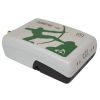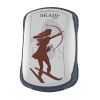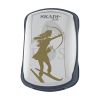Eos Skadi 100 GNSS Receiver
Features
- Provides 40-60 cm-level real-time accuracy using free SBAS corrections only
- Optimized for tough conditions, including dense canopy and urban cityscapes
- Easily shift from a handheld configuration to a range pole mount using included accessories
- Free ground shipping
- Expedited repair and warranty service
- Lifetime technical support
- More
Overview
The Skadi 100 is the entry-level GNSS receiver in the Skadi Series from Eos Positioning Systems. With single-frequency support for all GNSS constellations, the Skadi 100 lets you obtain submeter, mapping-grade accuracy in the field using only freely available satellite-based augmentation systems (SBAS) signals. The Skadi 100 is device agnostic to work with any iOS, Android, or Windows mobile device.
In addition to the accuracy and performance you have come to expect from any Eos GNSS receiver, the Skadi 100 also includes several advanced mapping capabilities available only in the Skadi Series product line. These include an integrated antenna and hot-swap, all-day battery to support any field mounting configuration. With the Skadi Standard Handle that is included in every Skadi 100 purchase, you can seamlessly switch from a handheld field configuration to a range-pole setup and more.
Advanced Mapping Features
The Skadi 100 is the only multi-constellation, device- and app-agnostic GNSS receiver in the Skadi Series product line designed to maximize worldwide submeter accuracy from free SBAS corrections or from an Atlas H50 subscription. With support for four global GNSS constellations, the Skadi 100 is one of the most advanced single-frequency submeter GNSS receivers on the market. Moreover, the Skadi 100 takes advantage of brand-new Skadi Series features including shapeshifting in the field and the Skadi Standard Handle.
Shapeshift in the Field
The Skadi 100 features an integrated antenna and hot-swap, all day battery. These let you work all day in the field with the flexibility of changing your field mounting setups — without wasting time handling any clunky mounting gear nor having to restart your receiver. The Skadi 100’s innovative design and hot-swap battery let you seamlessly move between the included Skadi Standard Handheld configuration, a full or half-sized surveying range pole, and a backpack range pole, for example. Additionally, an external antenna port and cables are available for those who’d wish to mount to a vehicle or use in a hands-free carry-on setup (e.g., backpack, safety vest, chest pack).
Skadi Standard Handle
The Skadi 100 comes with the Skadi Standard Handle, an ergonomic handheld device that allows you to easily combine your mobile smartphone or tablet and GNSS receiver in a flexible, light-weight single hardware setup. Additionally, the Skadi Standard Handle comes out of the box with the correct brackets that free your device’s camera to support any iOS, Android, or Windows smartphone or tablet — no additional purchase necessary.
- Skadi 100 GNSS Receiver with Integrated Antenna
- Pole Mounting Plate for Skadi Series
- Skadi Standard Handle
- Phone Mounting Bracket for Skadi Series Handles
- Tablet Mounting Bracket for Skadi Series Handles
- Skadi Series Li-Ion Battery Pack
- USB-C Power Block
- USB-C Cable
In The News
Floating Global New Ideas: Buoy-Enabled Research at Florida Agricultural and Mechanical University’s School of the Environment
Florida Agricultural and Mechanical University (FAMU), based in Tallahassee, Florida, is the highest-rated public Historically Black College or University in the United States. FAMU’s School of the Environment (FAMU-SOE) offers BS and BA degrees in Environmental Studies, and BS, MS, and Ph.D. degrees in Environmental Science, with specialisms available in areas including Environmental Policy and Risk Management, Aquatic and Terrestrial Ecology, and Biomolecular Sciences. In 2021, FAMU-SOE deployed a NexSens CB-450 buoy in Apalachee Bay, a key oyster farming area around 30 miles south of Tallahassee. The buoy has quickly been incorporated into the curriculum, providing environmental insights for student research, the community, and beyond. Dr.
Read MoreMonitoring Habitat Suitability and Water Quality in Northwest Arkansas Springs
Northwest Arkansas has seen an economic, industrial, and population boom in recent years as a result of expanding businesses, which have created thousands of jobs in the region and the mass migration of employees and construction companies. However, with this growth has come rapid urbanization and the degradation of the natural landscape, specifically the freshwater springs that can be found throughout the region. These springs are critical habitat centers for native wildlife, home to threatened and endangered fish, and those that have yet to be listed. Zach Moran, Assistant Professor of Fisheries Science at Arkansas Technical University, is working to help monitor these habitats and provide key data that will hopefully inform future development in the region.
Read MoreThree Decades of Research at Acton Lake
A multi-disciplinary team at Miami University, Ohio, has been studying the environmental change at Acton Lake for over three decades. Using three different NexSens buoys over this time, the team has an incredible archive of data that is helping build a picture of Acton’s past, present, and future. Until recently, a NexSens CB-50 buoy was used alongside other environmental monitoring at Acton Lake. In May 2025, the Miami team deployed a new XB-200 buoy , future-proofing their ongoing monitoring using real-time buoy systems. Acton Lake, a small hypereutrophic reservoir in southwest Ohio, covers 2.4km² and has a maximum depth of about 8m. The dam was built in 1956, and the lake has a large agricultural watershed.
Read More































